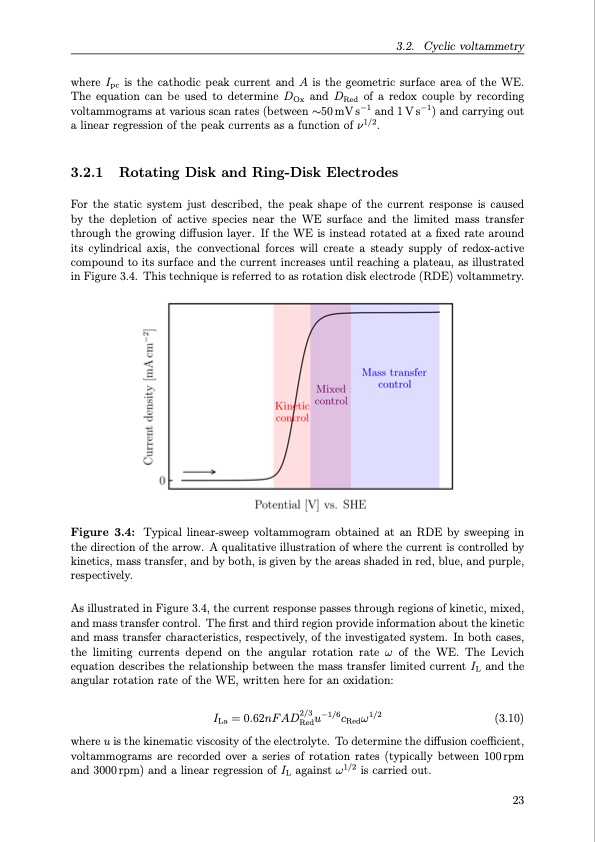
PDF Publication Title:
Text from PDF Page: 044
where Ipc is the cathodic peak current and A is the geometric surface area of the WE. The equation can be used to determine DOx and DRed of a redox couple by recording voltammograms at various scan rates (between ∼50 mV s−1 and 1 V s−1) and carrying out a linear regression of the peak currents as a function of ν1/2. 3.2.1 Rotating Disk and Ring-Disk Electrodes For the static system just described, the peak shape of the current response is caused by the depletion of active species near the WE surface and the limited mass transfer through the growing diffusion layer. If the WE is instead rotated at a fixed rate around its cylindrical axis, the convectional forces will create a steady supply of redox-active compound to its surface and the current increases until reaching a plateau, as illustrated in Figure 3.4. This technique is referred to as rotation disk electrode (RDE) voltammetry. Figure 3.4: Typical linear-sweep voltammogram obtained at an RDE by sweeping in the direction of the arrow. A qualitative illustration of where the current is controlled by kinetics, mass transfer, and by both, is given by the areas shaded in red, blue, and purple, respectively. As illustrated in Figure 3.4, the current response passes through regions of kinetic, mixed, and mass transfer control. The first and third region provide information about the kinetic and mass transfer characteristics, respectively, of the investigated system. In both cases, the limiting currents depend on the angular rotation rate ω of the WE. The Levich equation describes the relationship between the mass transfer limited current IL and the angular rotation rate of the WE, written here for an oxidation: ILa = 0.62nF AD2/3 u−1/6cRedω1/2 (3.10) Red where u is the kinematic viscosity of the electrolyte. To determine the diffusion coefficient, voltammograms are recorded over a series of rotation rates (typically between 100rpm and 3000 rpm) and a linear regression of IL against ω1/2 is carried out. 3.2. Cyclic voltammetry 23PDF Image | Organic Redox Flow Batteries 2023

PDF Search Title:
Organic Redox Flow Batteries 2023Original File Name Searched:
PhD_thesis_final_dorhoff_4_.pdfDIY PDF Search: Google It | Yahoo | Bing
Salgenx Redox Flow Battery Technology: Salt water flow battery technology with low cost and great energy density that can be used for power storage and thermal storage. Let us de-risk your production using our license. Our aqueous flow battery is less cost than Tesla Megapack and available faster. Redox flow battery. No membrane needed like with Vanadium, or Bromine. Salgenx flow battery
| CONTACT TEL: 608-238-6001 Email: greg@salgenx.com | RSS | AMP |